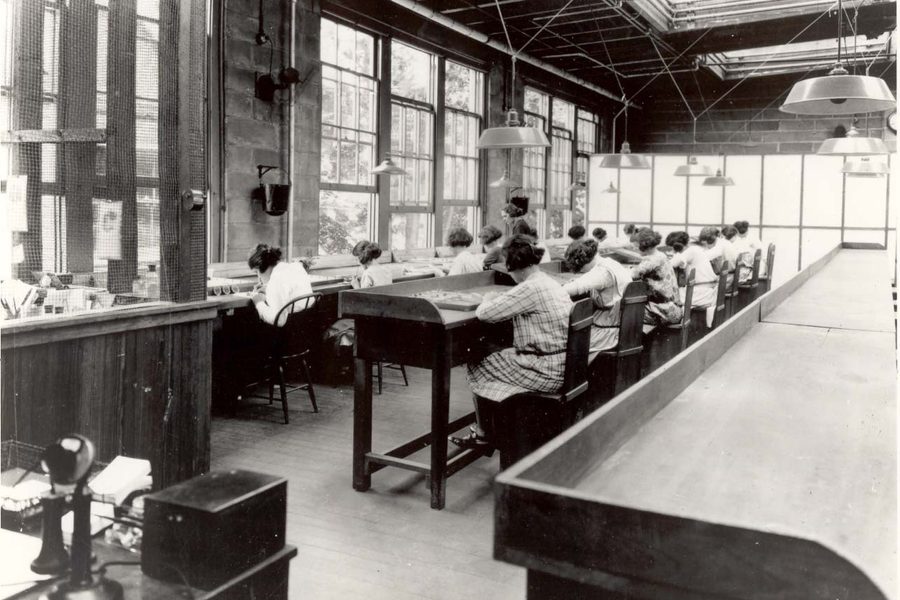
The town of Ottawa, Ill., is banding together to honor the memories of watch dial painters who were poisoned by a radium paint in the town during the 1920s and 1930s.
The campaign to build a monument in their honor is being spearheaded by Madeline Piller, 17, a local high school senior who became captivated by the story of the “Radium Girls” while working on a play about their story as part of an 8th grade history project.
The Peoria chapter of the National Organization for Women (NOW) awarded Piller its Young Feminist Award in 2007 for her work. When Piller got back from Peoria, she started raising $40,000 to erect the first monument to the Radium Girls in her home town. Laborers Local Union 393 has contributed $7,000 to the project so far.
Piller’s father, William, is a sculptor who has donated most of the labor to make the bronze statue of a young dial painter. The memorial will be erected on the site of a former dial painting plant, on a plot of land donated by the city. If all goes according to plan, the monument will be unveiled on April 28, Workers’ Memorial Day.
The U.S. Radium Corporation started making glowing watches in Ottawa in 1922. Instructors at the Ottawa Radium Dial Studio, as the plant was known, taught the girls to “tip” their camel hair brushes between their lips to maintain a fine point. It was a technique borrowed from the china painting industry.
Brush-sucking was probably an unsafe way to hand paint china, but with radium the technique became a death sentence.
The women were told that the paint — a mixture of glue, water, and radium powder — was harmless. An instructor once made a show of swallowing some just to prove the point. The girls entertained themselves by playing with the “harmless” paint, decorating their nails and teeth with the luminous mixture.
The radium they were using emits low-energy radiation, which bounces harmlessly off the skin. However, if the material is swallowed, it permanently insinuates itself into the skeleton, where it continues to emit radiation for the rest of the victim’s life, and indeed long after she is dead. Investigators would later measure the radioactivity in the bones of long-dead dial painters to prove that they had been poisoned.
As the dial painters ingested more and more paint, their skeletons crumbled from within. Their teeth fell out, their jaws shattered. They suffered from excruciating bone pain from fractures, crippling anemia as the radiation killed blood-forming cells in their bone marrow, and various cancers.
Over 1,000 women worked in the radium dial industry in different factories over the course of a decade. The Ottawa plant was the nation’s largest, employing about 100 women at any given time.
Between 1922 and 1924, four dial painters at U.S. Radium’s sister plant in Orange, N.J., died under mysterious circumstances. Officially, the causes of death were listed as phosphorous poisoning, mouth ulcers, or syphilis. By this point, many of the painters suspected the paint was killing their co-workers.
At the request of local health authorities, Consumers League of New Jersey brought in eminent outside experts to investigate. Harvard physiology professor Cecil Drinker found that the plant was heavily contaminated with radium. Drinker urged U.S. Radium to protect its workforce in a 1924 report, but company president Arthur Roeder dismissed Drinker’s findings and forbade him to publish his results.
In 1927, five former painters from the Radium Dial plant in East Orange, N.J., began a legal fight for compensation. It was during this highly publicized court battle that the women were dubbed “Radium Girls” in the press.
With the help of the Consumers League of New Jersey, experts in the nascent field of occupational toxicology, and crusading investigative reporters, the five East Orange Radium Girls eventually won a token settlement in the late 1920s.
Back in Ottawa, company doctors examined the painters and assured them they were perfectly healthy. In fact, the tests revealed radium in the women’s bodies, but they were never informed. The ruse was exposed in a Chicago courtroom in 1938 when former painter Catherine Wolfe Donahue sued her former employer. She ultimately accepted a token settlement and died shortly thereafter, leaving a husband and two young children.
The Ottawa Radium Dial Studio was shut down amid lawsuits in the 1930s, but it re-opened under a new name, Luminous Processes, with some of the same management. Luminous Processes continued to make watch dials with radioactive materials until the 1970s, when it was shut down by nuclear regulators for mishandling tritium. The EPA spent $80 million to clean up the site.
The plight of the Radium Girls became an impetus for tighter occupational health an safety laws nationwide.
On April 28, on the site of the old Luminous Processes plant, the City of Ottawa hopes to confront its past and honor the memories of the Radium Girls.







